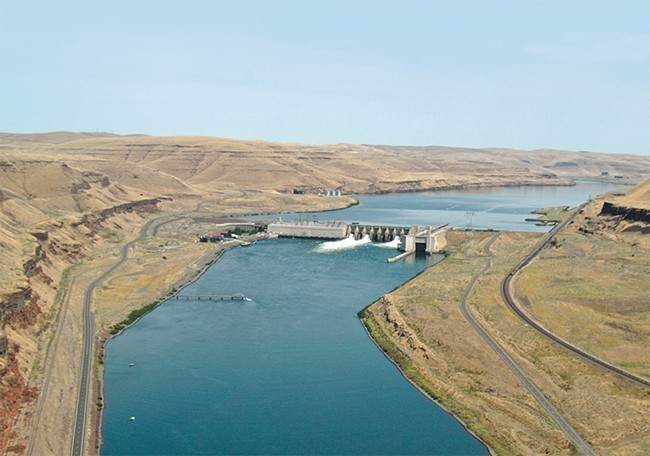forum
library
tutorial
contact

Can't We Seek Common Ground
on Dam/Fish Divide?
by Jeff Sayre
Lewiston Tribune, September 15, 2019
|
the film forum library tutorial contact |

|
Can't We Seek Common Ground
by Jeff Sayre
|
The closest unit trains to Lewiston are 74 miles and 124 miles away, respectively.
The short rail is all gone. It's been abandoned and shipped to China.
 One of the things that brought me back to Lewiston in October 1987 was a job at KLEW-TV.
One of the things that brought me back to Lewiston in October 1987 was a job at KLEW-TV.
And the second thing was fishing for steelhead.
Making TV spots and promotional videos, it's fair to say I made a living on the Snake and Clearwater rivers shooting video for 17 years.
I worked for aluminum jet boat manufacturers, jet boat tour companies, the U.S. Army Corps of Engineers, the Port of Lewiston, the Port of Clarkston, outdoor TV programs and the North Central Travel Association, to name a few.
The two rivers along with awesome walking paths on both sides of the rivers, beautiful weather most of the year and fishing year-round made it a paradise in my eyes.
Many people who visit here end up moving here for those reasons.
People who stop at the top of the Lewiston Hill marvel at its beauty in day time and night time.
One way or another, my life and my family's lives have been positively impacted by those rivers. Both my children learned to fish in these rivers. I've been involved in many aspects of its operations as a citizen and having worked for former U.S. Sen. Larry Craig, R-Idaho.
I even helped raise coho salmon from eggs to small fry to smolts and helped release them into a few local rivers and streams with members of the Nez Perce Tribe and Potlatch's Pulp and Paper Resource Council.
I still go to Spalding Park in October to sit and watch them spawn.
I documented underwater chinook salmon spawning in oxbow streams on the Idaho-Montana border.
I also tore up my shoulder last summer fishing for chinook on the South Fork of the Clearwater River and just ate the last pieces of the best salmon table fare a few weeks ago from the ones my son caught while I was in the emergency room.
The battle to take out the lower Snake River dams or keep them in place as working rivers has been going on for about 30 years — and longer if you count the time spent discussing building yet another dam above Asotin on the Snake River.
Idaho's water will be the new gold of this century. There will be more demands for its power and use as Idaho's population grows.
We can debate whether the electricity from those four dams is needed or not, and if solar and wind can fill the gaps until we are all blue in the face. Currently they produce enough electricity for 1.87 million homes. Hydropower works when the sun is not shining and the wind is not blowing.
We enjoy the lowest kilowatt hour electric fees in the entire U.S. because of clean hydro.
If you drive from Spokane to Grangeville, it's easy to see that agriculture dominates the scenery on both sides of the road and wheat is king.
In many rural Idaho, Oregon and Washington communities, agriculture keeps them alive.
Entire rural, local and regional economies are built around the Snake River and all it provides. This includes not just agriculture, but tourism, recreation, taxes and international transportation.
Many know-it-alls in Boise and certain environmental groups ask: Why not switch grain shipping to rail and roads? They falsely claim that unit trains are taking the largest share of the grain grown around Lewiston to Portland and Seattle.
Wrong. The closest unit trains to Lewiston are 74 miles and 124 miles away, respectively.
The short rail is all gone. It's been abandoned and shipped to China.
One grain barge holds about 120,000 bushels of wheat, the equivalent of 35 grain hopper rail cars or 134 semi-trucks.
 The two grain export companies that operate in the Lewiston-Clarkston Valley, 465 miles from the Pacific Ocean, use energy and cost-efficient barges on the Snake River to ship about 20 million bushels of wheat to Portland and the Asian Pacific a year. It's the most in-demand, top-quality wheat in the world, grown right here in our front and back yards.
The two grain export companies that operate in the Lewiston-Clarkston Valley, 465 miles from the Pacific Ocean, use energy and cost-efficient barges on the Snake River to ship about 20 million bushels of wheat to Portland and the Asian Pacific a year. It's the most in-demand, top-quality wheat in the world, grown right here in our front and back yards.
Why would you interrupt international markets and financially harm thousands of family farmers, regional economies and communities?
Blind ideology?
Am I subject to blind ideology, too?
This issue has been in court too long. It's the most complex natural resource issue in the West if not the U.S.
So many people and groups are involved. So much is at stake. So many people are affected, no matter what happens.
I still believe we can have both dams and salmon.
On Thursday and Friday, Idaho Gov. Brad Little's, Salmon Working Group will be in Lewiston. The second day is open to the public. Please attend and comment.
Tell work group members it's time to work together to find solutions that work for all of us.
It's time to use all we have in America at our disposal to find a dam good solution.
Please work together. Listen. Hear.
Remember, we put a man on the moon.
Related Pages:
Puget Sound's Orcas are Dying from Pollution, Not Dams by Jeff Sayre, Lewiston Tribune, 2/3/19
learn more on topics covered in the film
see the video
read the script
learn the songs
discussion forum
